Japanese net users upset over the power company’s use of a slang term commonly found in anime.
Tokyo Electric Power Company, known as TEPCO for short, has found itself under fire yet again. The company first became infamous following their questionable handling of the nuclear disaster at the Fukushima Daiichi Nuclear Power Plant, for which it served as operator following the March 2011 Tohoku earthquake and tsunami.
Late last month TEPCO tweeted a photo of the Fukushima Daiichi Unit 4 Reactor’s fuel pool along with the controversial hashtag #PlantMoe (#KojoMoe/#工場萌え), meant to evoke a love for the scenery of industrial power plants or factories. Readers may recognize the term moe from its common use in manga, anime, and video games to signify a style and/or passionate love for exceedingly cute characters.
With that in mind, it was probably not the best choice of words to describe one of Japan’s worst disasters in recent history. Following the backlash of online reactions to the hashtag, the company subsequently deleted the tweet and reuploaded a new version.
▼ TEPCO’s formal apology.
(Translation below)
【お詫び】
— 東京電力ホールディングス 株式会社 (@OfficialTEPCO) October 29, 2018
この度、本アカウントの投稿により、皆さまにご不快な思いをおかけし大変申し訳ございませんでした。深くお詫び申し上げます。
不適切なキーワードを含む記事を訂正させて頂くために再度、投稿させて頂きます。今回頂いたご意見を真摯に受け止め、今後の活動に活かして参ります。
“[Apology]
We are terribly sorry for our lack of consideration to everyone through the recent tweet in our account. We deeply apologize.
This post has been reuploaded to replace the previous one which contained an inappropriate keyword. We have taken your reactions into serious account and will pay closer attention to our online activity in the future.”
▼ The new version of the photo, minus the hashtag.
【再掲】
— 東京電力ホールディングス 株式会社 (@OfficialTEPCO) October 29, 2018
福島第一原子力発電所 4号機 燃料プール
Unit4 Spent Fuel Pool at Fukushima Daiichi Nuclear Power Station#東京電力 #東電 #tepco https://t.co/Pi49svVAbL pic.twitter.com/tvE9f2VL7W
Given the serious nature of the 2011 disasters, and the fact that a large portion of Fukushima residents are still displaced from their homes near the nuclear plant seven years later, it’s no wonder that net users found the slang term to be in poor taste when coupled with this photo.
TEPCO’s official Twitter account even features a formal apology for the 2011 debacle in the very first line of their profile description, so they probably should have known better.
On top of that, TEPCO reported in late September that they had detected more than 20,000 times the regular emissions standard of radioactive materials in a section of a contaminated water tank that they subsequently purified on the plant’s premises. Perhaps whoever is in charge of the company’s Twitter account should take care to treat anything relating to 3/11 with more gravity.
Sources: Twitter/@OfficialTEPCO, Asahi Shimbun
Featured image: Twitter/@OfficialTEPCO
[ Read in Japanese ]

 U.S. military personnel launch US$5 billion lawsuit against Tokyo Electrical Power Company
U.S. military personnel launch US$5 billion lawsuit against Tokyo Electrical Power Company Japan government makes cute illustrated version of radioactive isotope it plans to dump into sea
Japan government makes cute illustrated version of radioactive isotope it plans to dump into sea First worker to die from Fukushima radiation exposure officially recognized by Japan’s government
First worker to die from Fukushima radiation exposure officially recognized by Japan’s government Take a tour of the Fukushima Daiichi Nuclear Power Plant seven years after the disaster 【Video】
Take a tour of the Fukushima Daiichi Nuclear Power Plant seven years after the disaster 【Video】 Fukushima bottled water wins Gold Quality Award in the internationally coveted Monde Selection
Fukushima bottled water wins Gold Quality Award in the internationally coveted Monde Selection Seaside scenery, history, and so many desserts on Yokohama’s Akai Kutsu【Japan Loop Buses】
Seaside scenery, history, and so many desserts on Yokohama’s Akai Kutsu【Japan Loop Buses】 Do Hi-Chew-flavor Hi-Chews have a reason to exist?【Taste test】
Do Hi-Chew-flavor Hi-Chews have a reason to exist?【Taste test】 Mikado Coffee is a 76-year-old coffee chain with a major celebrity connection
Mikado Coffee is a 76-year-old coffee chain with a major celebrity connection Japan’s summertime towelket pillowcases are even better with the addition of Ghibli stars【Photos】
Japan’s summertime towelket pillowcases are even better with the addition of Ghibli stars【Photos】 Foreigner’s request for help in Tokyo makes us sad for the state of society
Foreigner’s request for help in Tokyo makes us sad for the state of society Limited-edition Carbonara Udon will anger noodle purists and pasta lovers 【Taste test】
Limited-edition Carbonara Udon will anger noodle purists and pasta lovers 【Taste test】 Sandwiches fit for a sumo served up in Osaka【Taste Test】
Sandwiches fit for a sumo served up in Osaka【Taste Test】 Harajuku Station’s beautiful old wooden building is set to return, with a new complex around it
Harajuku Station’s beautiful old wooden building is set to return, with a new complex around it Should you add tartar sauce to Japanese curry rice? CoCo Ichi makes diners an unusual offer
Should you add tartar sauce to Japanese curry rice? CoCo Ichi makes diners an unusual offer We eat at three Japanese family restaurants to find the one with the best-value breakfast
We eat at three Japanese family restaurants to find the one with the best-value breakfast McDonald’s new Happy Meals offer up cute and practical Sanrio lifestyle goods
McDonald’s new Happy Meals offer up cute and practical Sanrio lifestyle goods Japanese ramen restaurants under pressure from new yen banknotes
Japanese ramen restaurants under pressure from new yen banknotes French Fries Bread in Tokyo’s Shibuya becomes a hit on social media
French Fries Bread in Tokyo’s Shibuya becomes a hit on social media Studio Ghibli releases new action figures featuring Nausicaä of the Valley of the Wind characters
Studio Ghibli releases new action figures featuring Nausicaä of the Valley of the Wind characters Red light district sushi restaurant in Tokyo shows us just how wrong we were about it
Red light district sushi restaurant in Tokyo shows us just how wrong we were about it New private rooms on Tokaido Shinkansen change the way we travel from Tokyo to Kyoto
New private rooms on Tokaido Shinkansen change the way we travel from Tokyo to Kyoto Tokyo Tsukiji fish market site to be redeveloped with 50,000-seat stadium, hotel, shopping center
Tokyo Tsukiji fish market site to be redeveloped with 50,000-seat stadium, hotel, shopping center Beautiful Ghibli sealing wax kits let you create accessories and elegant letter decorations【Pics】
Beautiful Ghibli sealing wax kits let you create accessories and elegant letter decorations【Pics】 Japanese city loses residents’ personal data, which was on paper being transported on a windy day
Japanese city loses residents’ personal data, which was on paper being transported on a windy day Studio Ghibli releases Kiki’s Delivery Service chocolate cake pouches in Japan
Studio Ghibli releases Kiki’s Delivery Service chocolate cake pouches in Japan New definition of “Japanese whiskey” goes into effect to prevent fakes from fooling overseas buyers
New definition of “Japanese whiskey” goes into effect to prevent fakes from fooling overseas buyers Our Japanese reporter visits Costco in the U.S., finds super American and very Japanese things
Our Japanese reporter visits Costco in the U.S., finds super American and very Japanese things All-you-can-drink Starbucks and amazing views part of Tokyo’s new 170 meter-high sky lounge
All-you-can-drink Starbucks and amazing views part of Tokyo’s new 170 meter-high sky lounge More foreign tourists than ever before in history visited Japan last month
More foreign tourists than ever before in history visited Japan last month New Pokémon cakes let you eat your way through Pikachu and all the Eevee evolutions
New Pokémon cakes let you eat your way through Pikachu and all the Eevee evolutions Disney princesses get official manga makeovers for Manga Princess Cafe opening in Tokyo
Disney princesses get official manga makeovers for Manga Princess Cafe opening in Tokyo Sales of Japan’s most convenient train ticket/shopping payment cards suspended indefinitely
Sales of Japan’s most convenient train ticket/shopping payment cards suspended indefinitely Sold-out Studio Ghibli desktop humidifiers are back so Totoro can help you through the dry season
Sold-out Studio Ghibli desktop humidifiers are back so Totoro can help you through the dry season Japanese government to make first change to romanization spelling rules since the 1950s
Japanese government to make first change to romanization spelling rules since the 1950s Ghibli founders Toshio Suzuki and Hayao Miyazaki contribute to Japanese whisky Totoro label design
Ghibli founders Toshio Suzuki and Hayao Miyazaki contribute to Japanese whisky Totoro label design Doraemon found buried at sea as scene from 1993 anime becomes real life【Photos】
Doraemon found buried at sea as scene from 1993 anime becomes real life【Photos】 Tokyo’s most famous Starbucks is closed
Tokyo’s most famous Starbucks is closed One Piece characters’ nationalities revealed, but fans have mixed opinions
One Piece characters’ nationalities revealed, but fans have mixed opinions We asked a Uniqlo employee what four things we should buy and their suggestions didn’t disappoint
We asked a Uniqlo employee what four things we should buy and their suggestions didn’t disappoint Princesses, fruits, and blacksmiths: Study reveals the 30 most unusual family names in Japan
Princesses, fruits, and blacksmiths: Study reveals the 30 most unusual family names in Japan Haruki Murakami’s solution to the nuclear power debate in Japan: Actually call it “nuclear power”
Haruki Murakami’s solution to the nuclear power debate in Japan: Actually call it “nuclear power” Common ramen ingredient found highly effective at clearing up radioactive contamination
Common ramen ingredient found highly effective at clearing up radioactive contamination U.S. military in Japan bulk buys Japanese scallops as China’s Japanese seafood ban continues
U.S. military in Japan bulk buys Japanese scallops as China’s Japanese seafood ban continues Don’t forget: Yahoo! Japan to make disaster relief donation for every person who searches for “3.11” today
Don’t forget: Yahoo! Japan to make disaster relief donation for every person who searches for “3.11” today Outburst by Japanese minister at press conference overshadowed by…his Eva anime tie
Outburst by Japanese minister at press conference overshadowed by…his Eva anime tie New species of mayfly discovered in Fukushima that can never get their prescription glasses
New species of mayfly discovered in Fukushima that can never get their prescription glasses New research suggests even low-level radiation in Fukushima negatively impacting wildlife
New research suggests even low-level radiation in Fukushima negatively impacting wildlife Synthetic fossil fuels made from light, water, and CO2 in the air tested in Osaka
Synthetic fossil fuels made from light, water, and CO2 in the air tested in Osaka Emotional photos of Fukushima are turned into a moving tribute in gorgeous joint project【Video】
Emotional photos of Fukushima are turned into a moving tribute in gorgeous joint project【Video】 Discovery of unregistered radioactive substance in Japanese university shocks students
Discovery of unregistered radioactive substance in Japanese university shocks students Strong earthquake hits Japan as anniversary of Fukushima disaster approaches【Photos, Videos】
Strong earthquake hits Japan as anniversary of Fukushima disaster approaches【Photos, Videos】 Geminoid F: Japan’s android actress with a starring role in a new film 【Video】
Geminoid F: Japan’s android actress with a starring role in a new film 【Video】 Tohoku tsunami survivor’s $12K camera: heart-felt gift or PR stunt?
Tohoku tsunami survivor’s $12K camera: heart-felt gift or PR stunt? Moving video commemorates anniversary of the 2011 Tohoku earthquake and tsunami in Japan
Moving video commemorates anniversary of the 2011 Tohoku earthquake and tsunami in Japan Annual Tokyo memorial for March 11 tsunami comes with a heartwarming musical surprise【Video】
Annual Tokyo memorial for March 11 tsunami comes with a heartwarming musical surprise【Video】 Honda readying a Fuel Cell Vehicle for buyers next year, just in time to challenge Toyota
Honda readying a Fuel Cell Vehicle for buyers next year, just in time to challenge Toyota
Leave a Reply